After a career in enduro racing that made him one of New Zealand’s most successful exponents, Jamie Nicoll turned his mind to adventures. The relationships he’d made with sponsors on the racing stage, were strong enough to convert into a new venture: come up with a plan for some sort of voyage into the unknown, and get it supported. Jamie Nicoll Adventures is the result.
A series of adventures have followed, to many points of the compass. His home is a bus he has owned for twenty years and rebuilt several times. Jamie has a pair of Toyota Landcruisers one of them he has outfitted with everything required to survive a trip across the deserts of Australia.
When his bike sponsor, Santa Cruz, were thinking about launching the latest version of the bike they call the Nomad, it made sense that Jamie would be doing it.

The Nomad is perhaps the flagship product in the Santa Cruz stable. Conceived as a bike for the big day out, the Nomad led the charge into what are today’s enduro bikes. It isn’t the brand’s enduro race bike, but it is well-capable. It’s a 27.5” wheel brawler that gets as close as the designers could manage to DH performance, while retaining trail-ready behaviour.
To launch the Nomad meant a field trip, a camping journey into the wilds of Marlborough, and a couple of days of varied trails to try the bike out on, with our photographer Cam on a Santa Cruz e-bike to document proceedings.
The idea was to get together in Nelson, then road-trip to Whites Bay, sample some more riding en route, and finish the trip by riding Wakamarina, a trail I have been hearing about for decades. The editor did not have to ask twice – I was ready to go in minutes. Our first stop was Whites Bay. A nice little beach with a bush-clad DoC camp sits in the lap of a steep range, with Mt Robertson at the top. We circled the wagons (both of Jamie’s Landcruisers) and got acquainted with the bikes.
To look at, the new Nomad is like a squared off, muscled up version of its predecessor. An angular look and a side profile featuring acres of Carbon frame give the bike its unique appearance: it looks like something dangerous crouching for a spring. A little bit of air in the suspension, otherwise it felt like home exactly as delivered.

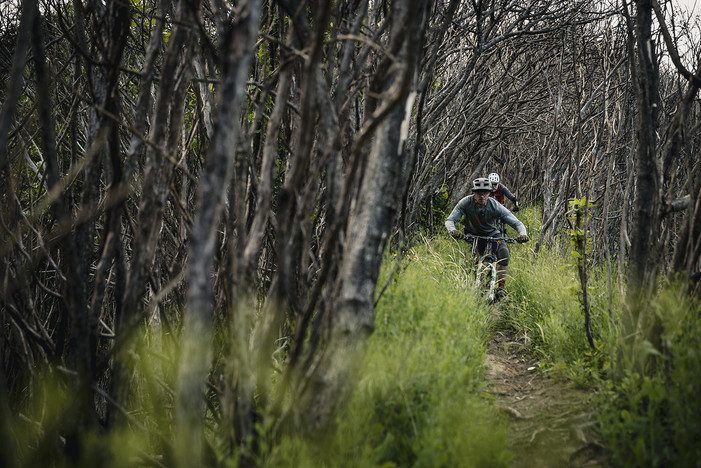




Beginning a relationship with a bike is probably best done somewhere other than a 680m ascent. Even a three-day fling would probably turn out happier if there was a gentler start but, after checking the sign, we saw that a DoC walking track directly from the campsite was ok for bikes going up – and that was us, so up we went. The trail was a perfect singletrack climb, and the bike was completely up for it.
170mm of suspension can be a liability when pedalling skywards, but we commented between breaths how nailed modern bikes have become. Sitting in the ‘low’ suspension, and with the shock wide open, it still motored uphill as well as any mountain bike with me on top of it.
The Whites Bay trails are a nice little set: The Loop trail was our first target. When the climbing trail crossed the gravel road that takes traffic by an incredibly arduous route to Picton, it turned into a four-wheel-drive track. A steep one, with some sections near the top that were at the edge of what can be done under pedal power. You could be excused for thinking you are near the top at the trail entrance proper – you aren’t. Forsaking the downhill Double Eagle trail, we continued to climb. Another 500m – the majority of the overall altitude gain – happens on singletrack, in beautiful beech forest. It is probably all doable – on the occasional moments where I could see Jamie, it was clear he was riding, but it was too much for me. Repeated very steep, fairly technical sections put the idea of cleaning everything well out of mind – nothing to prove, plenty more hills to clamber up, save some energy for the next days.
Eventually we were at the summit as far as we were concerned, but enthusiasts can turn right and continue up to Mt Robertson’s lofty top, another 400m vertical and three difficult kilometres in the distance. We turned left and started down.
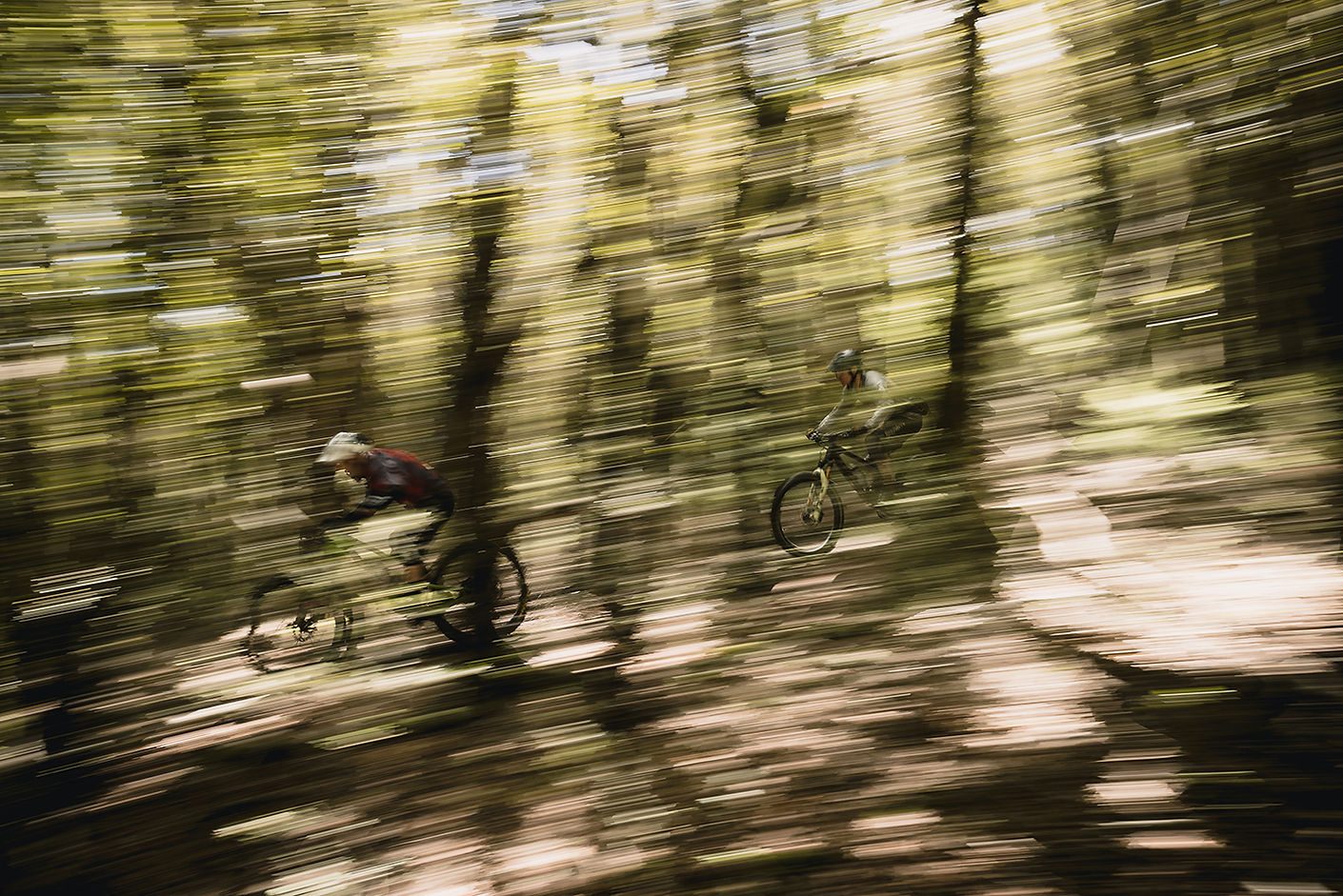
I am already scheming a return trip. About four kms of varied trail beckon me back. Roots, rock, ruts and flow are all there in abundance, as well as some excellent views out to the north and east over mountains and sea.
Already I had realised that the Nomad would eat up whatever I pointed it at. The Fox 38 up front was burly and compliant enough that with a bit of momentum I could clatter over very intimidating terrain without a bother. The back end was not even there – so supple and bottomless feeling that all my focus was on the trail and my aim.
The second course was a Landcruiser shuttle back to the top, then the Double Eagle. Another one on my ‘revisit sometime soon’ list. It will be a brilliant trail on the day I get back there, after a week or so of summer dryness, but for the one percenters I guess it actually was brilliant the day we rode it. For me, however, in the conditions, it was a struggle. Lots of rain made a layer of lubrication between the leaf litter and the solid dirt, which meant brakes were useless and the only way to ride it was the way Jamie does – with no brakes.
We repeated the performance on another trail of dubious legality – a really cool ridge running into a tight little valley. Jamie looking unfazed; I was hanging on for grim death.
Even on a very short trip, campsite routine gets established early. The usual operation revolved around Jamie, as the host, pulling out the ingredients and implements, and setting to assembling a meal, while we offered small bits of assistance and discussed what we had seen and done, and what we were doing next. In our downtime we also marveled at the detail of the builds of the Landcruisers, especially the Australia Overlander it is bristling with clever, well-executed modifications, all completed by Jamie. In the morning, we headed over to the Jentree MTB Park, a private property owned and developed by Justin Leov and his partner Tory. Justin is one of New Zealand’s most successful pro downhillers, racing the World Cup circuit as part of a career spanning 16 years and really blazing the way for today’s young kiwi downhillers. Justin had several international podium finishes, and was a regular top ten world cup rider and multiple-time national title holder. After a failed attempt to retire, he followed up with a win and a third place overall in the Enduro World Series.
With racing behind him in 2017, the Leovs established Jentree MTB Park on a hill that had hosted downhill racing as far back as the 90s. We were keen to take a look and have a few runs.
It’s amazing what can be done with a relatively small piece of land and a lot of vision. A hundred acres packs in a lot of elevation – it is a 400m climb up a very steep track to the top of the property, and the start of an entertaining nest of trails. It felt like a well aimed rock could land on the Landcruiser parked way below. Even with such precipitous terrain, the trails are sustainably built to provide plenty of speed without creating places where hard braking would chop out the trail surface. A very inspiring project, and a great example of how to put a park together.


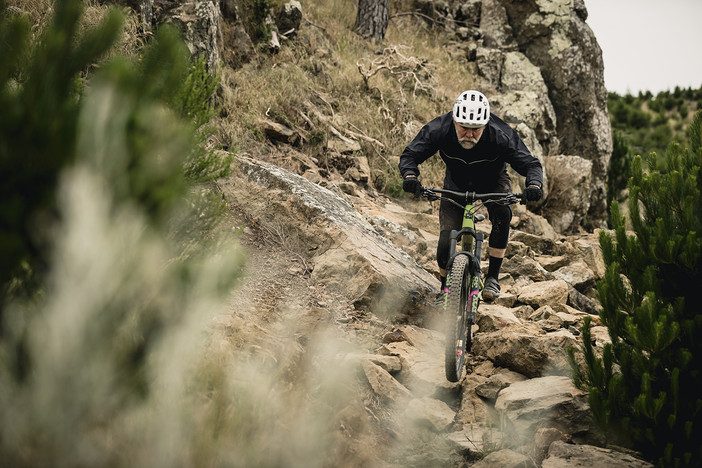



On the drive through to the Wakamarina River campsite, in Richmond Forest Park, we stopped for a bite to eat in Havelock. Whilst waiting for coffee, we consulted Trailforks and found a nearby trail called “Good-For-Nothing”. Allegedly dropping out of the bush a block or so from where we sat, it began on top of the ridge directly behind town. A bit more fossicking on Trailforks showed an access road not far away, so we loaded up one of the trucks and went to check it out.
After a nice rideable climb (mental note for future excursions) and another outstanding Marlborough view, we dropped into Good-For-Nothing.
You can’t tell a book by its cover, and you can’t read too much into a name. This little trail is only a tad over three kilometres long, but it is close to perfection in my humble opinion. The good people of Havelock may not enjoy dozens of trails on their doorstep, but the one they have is worth doing dozens of times. Rocky and exposed at the top, rocky and deep in the woods on the way down, loamy and almost jungly at the bottom. Yeehaw.
The drive in to Wakamarina from Canvastown on the main highway, follows a classic New Zealand backroad. Wide and easy-going to begin, the road gradually narrows, coils itself up, and sheds its tarmac before delivering punters to the very end. Facing a mountainside draped in beech forest, the grassy fields for campers were deserted except for one lonesome little van. The Wakamarina River runs beneath the campsite, a rocky watercourse with crystal clear water in deep pools and gentle rapids. Jumping in was more or less compulsory after our hot and dusty day, and the water was as cold as it was clear. Just to make sure, we jumped in again, and learned that once was probably enough. Another idyllic night under the stars followed, with Jamie slinging veggie burgers and all of us conking out fairly soon after dinner.
The next morning started early. Riding Wakamarina South-East-to-West (the only logical way to do it – see below) requires a bit of logistical maneuvering. It is about an hour and twenty around to the south-eastern trailhead, and we figured we would take about five hours to get through, allowing for the time it takes to ride a few stretches twice (or more) for photographic purposes. My slot for leaving Nelson was 4:30, and Nelson was an hour and a half away… we reckoned we had to be back at camp by one. That meant a 7am pickup by the Blue Moon shuttle driver from Havelock.
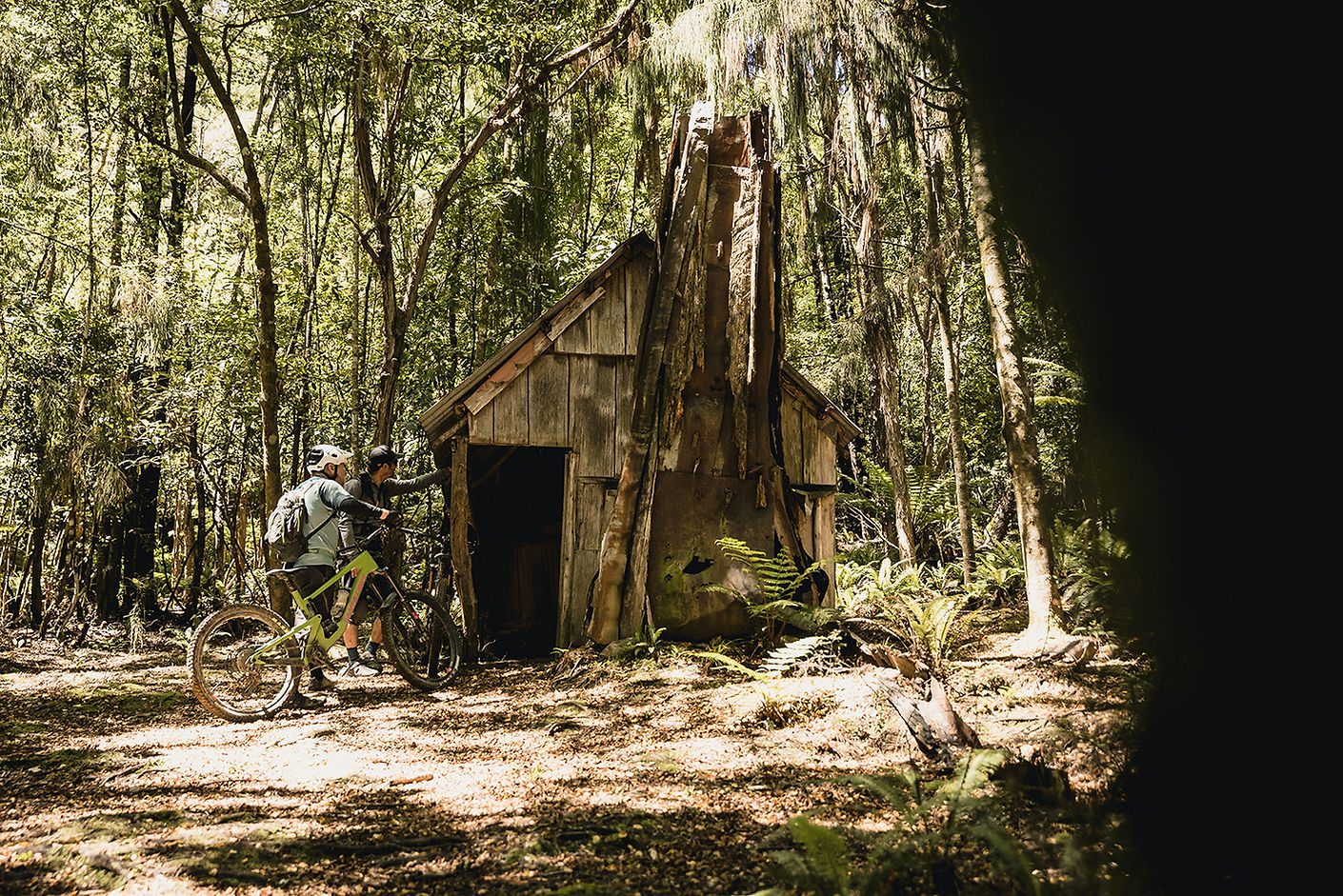
Excitement or sandflies saw us all out of the sleeping bags and into our kit by 6:15am. Even the knee pads were on …. sand-flies. A couple of stovetop coffees, morning ablutions, a bowl of Yum granola, and we were ready to hit the trail. The driver turned up on cue, and the big day started.
A note on the weather: it was perfect. Completely bluebird,but not really that hot. Lucky Strike #1. Lucky Strike #2 was being delivered right to the trailhead. The approach to the trail is through some forestry, and the word was that maybe it would be closed and we would be riding from about 6km short of the trailhead. That’s not far, but Wakamarina starts 600m above sea level. Having that 600m in the tank would be better than spending it getting started. Some of us had our own little lucky strikes along the way …. more on that later.
The trail sets out fairly flat, and even goes a little downhill, so we motored along feeling like the very lucky people we were. A few glimpses of the view were all we got, and soon enough the trail tipped up and we started to climb.
That first climb is only 5km or so, and gains about 500m – small numbers that do not reflect reality. It is hard! Stunningly beautiful trail has been carved out of the rock by miners in the 1800s and, in many places, it is much as it would have been then. The climb is unrelenting and follows a ridge to a saddle where a side trail leads up to a clearing at Fosters Hut.
The outlook from that point, over a kilometre above sea level, was spectacular.




The run back down to the saddle was followed by a long downhill with quite a few water crossings, which were slippery and exposed. That is where I had my Lucky Strike #3: coming into a section where the trail changed from a fairly well-formed surface to a V-shaped defile, with rough rocks on one side and a smooth sheet of rock rising up on the other. I should have stuck my front wheel into the bottom of the slot, but I had a go at the rock slab on the left. It was slipperier than it looked, and I fell hard onto it, landing on my hip, which still has a big lump on it. But, that was the only damage, from my only crash, so I was lucky. Actually, and more correctly, it was my only crash if you don’t count the other one.
After the last drop into a watercourse, a steep and boulder strewn thing best left to the one percenters, the legendary Wakamarina Hike-A-Bike began.
Marlborough trails seem to condense distance and difficulty to rock-hard things that confuse the newcomer. The hike-a-bike is one and a half kilometres long, and only gains 290m. Some of it is actually rideable. The bits that aren’t really aren’t, they are barely walkable. At one point, as I wrestled my now completely useless pile of carbon and alloy technology around a fallen tree that was hung up at 45 degrees on a similarly angled slope, I seriously wondered if I had left this particular life goal too late. As in, will I get to the top – alive? How our photographer managed with his even more useless e-bike and a gigantic pack full of cameras is anybody’s guess, I certainly couldn’t have.
But the thing about sections of trail like that, is that sooner or later, they do end. And to be honest, every so often I stopped toiling upwards and looked around – it is a majestic place to walk a bicycle. We came to a ridge, which I stupidly assumed was the top of the climb – it wasn’t, we were just over halfway. Far ahead, I could see Jamie pedalling a steep trail. That inspired me to get aboard my machine again, but the bits I could ride were so short that the time and effort it took to stop, clamber on, pedal away, then dismount ten metres along the trail were more than what I lost by plodding along on foot.
Not far shy of the actual summit we were back on our bikes and crawling along in low gear. Cam got a stick in his derailleur and snapped the entire mechanism off. Not the hanger, which could arguably be fixable, but the derailleur itself.

He pushed to the top, where Jamie was sunning himself and eating a snack. The chain was removed, and a gravity sled was the result. Perfect for what lay in front of us: 800 metres of descending in 2.5 kilometres.
Once again, that contraction of time and space: two and a half kilometres that will be burned into my memory for ever I hope: dozens of switchbacks, seas of ground ferns, massive buttress root systems supporting huge black-trunked beech trees, and a constant need to pay attention to where you are going. It felt like a lot further, but it was over much too soon.
The trail out is relatively flat. But only relatively. After we checked out the historic old slab hut at Devils Creek, we were in for a lumpy six kilometre run back to the cars – with plenty of time, on an operational bike. But of course, one of the bikes was not operational. An e-bike with no chain is about 250watts worse than a regular bike with no chain.
Cam was pretty keen to create a single speed out of the e bike. Both Jamie and I were pretty sure it wouldn’t work – compounding a chain’s general tendency to shift gears by itself until it is so loose it falls off is the suspension bike’s tendency to stretch the chain as the suspension goes though its motions. And of course, chains don’t stretch.
There was a brief stand-off, while discussion was had about whether trying to fix the bike would ultimately gain or waste time. In the end Cam won, and the two of them worked together to make the repair. Jamie got the quick link undone by hand (not easy) and Cam riveted the thing back together at what he thought was the right tension – and off he went.

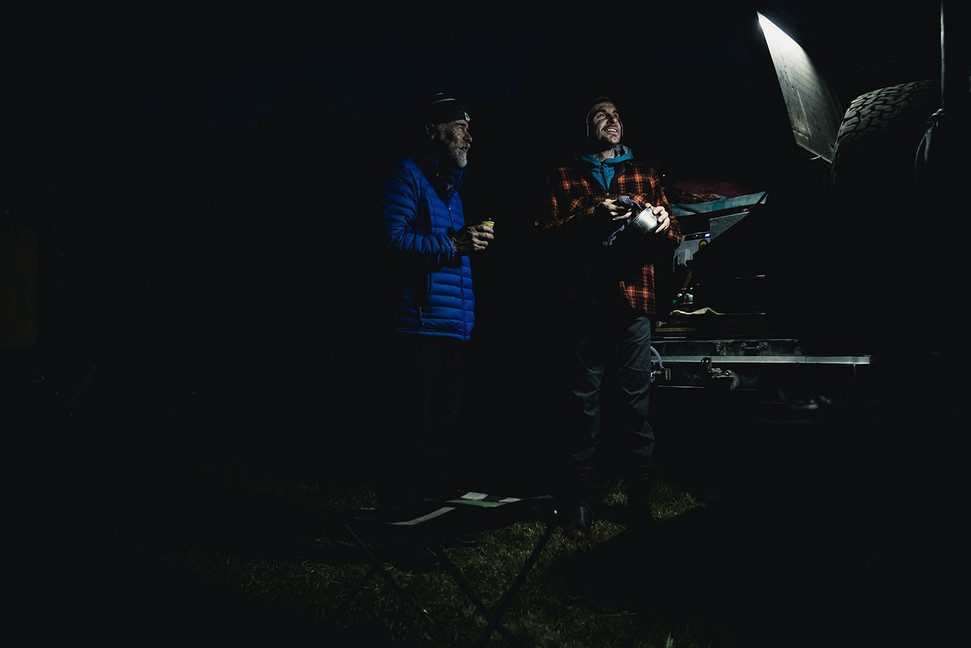
To our collective amazement, it held together long enough for the battery to go flat (it’s a big ride), and we got back right on schedule, something that never happens on a normal mountain bike ride, let alone with a giant traverse of a couple of ranges in a remote location, with a photographer.
At the end of three big days riding fresh trails, I had formed a trusting accord with the Nomad. It was there for me when I needed it, which was more often than not. It really lived up to its name. Rinsing off in the river was as lovely and brutal as it had been the day before. The three days on a Jamie Nicoll Adventure were over way too soon, but it felt like we had set out from Nelson a long time ago. That Marlborough time warp again.
Words: Gary Sullivan
Images: Cameron Mackenzie

